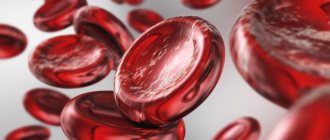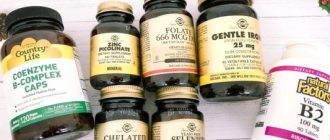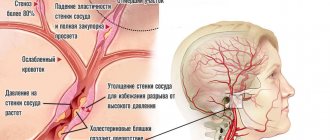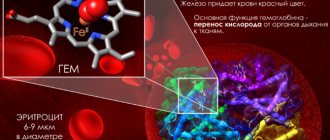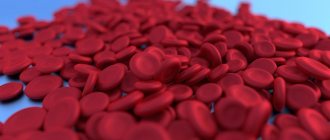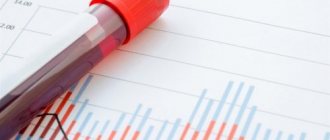What is low hemoglobin?
There are medical standards for hemoglobin content in the blood, different for each age category:
- women over 18 years of age – 115–140 g/l;
- men – 135-160 g/l;
- children from 5 to 12 years old – 115–145 g/l;
- for pregnant women – 100–110 g/l.
Low hemoglobin indicates that the organs are poorly supplied with oxygen; the body does not have enough of such an important trace element as iron. If the problem is not intervened in time, it can develop into a pathology. Cells cannot breathe without hemoglobin, so its content must always be normal.
Drugs that increase hemoglobin in the blood: list
How to increase hemoglobin at home quickly?
Reasons for decreased hemoglobin
Hemoglobin appears in the blood thanks to a balanced diet rich in iron. First of all, the attending physician must find out which diet predominates in the patient. If the patient eats meals that exclude meat, animal proteins and legumes, the first step is to restore a varied diet.
If the patient is eating a fairly healthy and nutrient-dense diet but still has low hemoglobin, a number of other tests should be performed.
If we are talking about a female patient of reproductive age, then first of all it is necessary to conduct an ultrasound examination of the pelvic organs to detect pathologies that cause heavy bleeding. In addition, it is important to understand how much a woman experiences monthly blood loss associated with the menstrual cycle. Often they become the physiological cause of decreases in hemoglobin. In this case, the gynecologist should suspect the presence of fibroids, which forces the walls of the uterus to contract intensively, causing increased blood loss.
If we are talking about a male patient or examination of the female reproductive system did not produce results, the next stage of examination should be gastroscopy and colonoscopy. These diagnostic methods will help identify internal bleeding that is not so heavy as to become noticeable, but its regularity causes a significant amount of blood lost.
The third, no less important reason why hemoglobin may decrease is leukemia. This disease is associated with a gene mutation and causes disturbances in the functioning of the hematopoietic system.
Signs of low hemoglobin
Iron deficiency is manifested by the following symptoms:
- lack of appetite;
- dry flaky skin;
- weak brittle nails;
- lifeless dull hair;
- causeless increase in temperature;
- general loss of strength;
- pale skin;
- the appearance of cracks on the lips;
- cardiopalmus;
- change in taste preferences;
- disruption of the defecation process;
- constant headaches;
- cold extremities, even in a warm room;
- fast fatiguability;
- unpleasant sensations in the legs, when there is a desire to simply move them in order to get rid of the discomfort;
Important! In some cases, low hemoglobin can only be detected after a blood test, since its course does not necessarily have to be accompanied by these symptoms, especially if the decrease differs slightly from the norm. Depends on the body. For prevention purposes, it is important to regularly have your blood tested.
Symptoms
The severity of symptoms largely depends on the level of hemoglobin: the lower it is, the more severe the anemia. Therefore, in mild cases, men may not notice changes in their well-being or not attach importance to them, since they are little expressed. In such situations, periodic weakness or increased fatigue may occur, but many attribute this to stress, age and other life circumstances. With a further decrease in hemoglobin, the situation becomes more complicated, the existing symptoms become more intense, and others appear.
Sometimes even a decrease in hemoglobin to 90 g/l is asymptomatic.
In general, a decrease in hemoglobin levels in men may appear:
- drowsiness, weakness, decreased performance;
- shortness of breath, which initially occurs due to physical exertion;
- feeling of heartbeat;
- dizziness that can lead to loss of consciousness;
- pallor of the skin and mucous membranes;
- increased irritability, aggressiveness;
- headaches of varying degrees of intensity;
- decreased appetite;
- increased brittleness of nails, the appearance of white spots and bumps on them;
- perversion of taste preferences with the emergence of a desire to eat inedible food, in particular raw meat, chalk, clay;
- developing an addiction to the smells of acetone, gasoline, perfume, etc.;
- ringing in the ears, flickering of spots before the eyes.
A symptom of decreased hemoglobin that is typical for men may be impaired erectile function.
Why is hemoglobin low?
There is no clear reason. It is impossible to talk about the development of pathology every time the hemoglobin level is below normal. This may be a temporary phenomenon caused by trauma with blood loss, surgery, donation, vegetarian diet, and in women, additionally, the menstrual cycle.
The basis for the development of the disease may be pathological processes occurring in the body:
- digestive problems (colitis, enterocolitis, dysbacteriosis);
- bleeding;
- failure of the immune system;
- infection of the body;
- leukemia, lymphoma;
- uterine fibroids, causing bleeding;
- disease of the hematopoietic system;
- tumors of various origins;
- kidney pathology.
It is important to know! During pregnancy, the hemoglobin level is 30 to 20 units below normal. But this is a temporary phenomenon that goes away after the birth of the child, in the absence of chronic diseases.
Why does the body need hemoglobin?
Hemoglobin provides oxygen transport. In the capillaries of the lungs, a maximum of four oxygen molecules bind to one oxygen molecule and form oxyhemoglobin. Then, in the blood stream, red blood cells deliver this ligament to organs and tissues. Here, the oxygen necessary for oxidative processes is freed from bonding with hemoglobin.
Iron is necessary for the normal functioning of the human immune system. A lack of this microelement can lead to problems with potency in men and disrupt the menstrual cycle in women. Low hemoglobin levels can also warn of other serious diseases.
Signs of iron deficiency in the body may include loss of energy, depression, hair loss and dry skin, drowsiness and irritability. However, to determine true anemia and replenish iron deficiency, it is necessary to conduct a detailed blood test.
At risk are vegetarians and fans of strict diets, teenagers during hormonal changes in the body, and child athletes who do not take additional vitamin and mineral complexes. If pregnant women do not take special multivitamins, they are also at risk of developing anemia.
The doctor reminds you that you should not buy drugs to replenish hemoglobin and ferritin reserves at the pharmacy yourself. They are prescribed only by doctors. In addition, the effect of the drugs begins only after six months and therefore the course of treatment cannot be interrupted.
What are the consequences if low hemoglobin is not treated?
Oxygen delivered by hemoglobin ensures the normal functioning of all organs. If it is not enough, then functional and organic changes begin, resulting in a life-threatening condition. The degree of damage depends on the duration of oxygen starvation, and the consequences lead to the formation of a number of pathologies:
- painful changes in the liver;
- development of shortness of breath;
- the appearance of pathological changes in the vascular and cardiac systems;
- disruptions in the functioning of the nervous structure;
- changes in the composition of the blood, a decrease in red blood cells - anemia;
- development of atherosclerosis;
- exacerbation of chronic diseases.
A slight decrease in hemoglobin relative to the norm is associated with weakness and increased fatigue. As the gap in indicators increases, a depressive state and irritability appear.
Note! A large lack of hemoglobin in pregnant women is fraught with premature birth and the development of hypoxia in the unborn child.
Interesting
If you smoke a lot, you may have anemia, even though a blood test shows normal hemoglobin levels. This happens because the carbon monoxide contained in cigarettes combines with hemoglobin and forms its special form. Such hemoglobin is not able to carry oxygen. And to make up for its deficiency, the body increases the production of hemoglobin, its level is high, but this is of little use. Therefore, abroad, for example, the hemoglobin level of smokers is calculated depending on the number of cigarettes smoked per day.
EL Clinic: methods of treating low hemoglobin
To prescribe effective treatment, it is necessary to establish the cause of the disease. Treatment methods depend on the duration of the disease, severity, and characteristics of the body. In general, all activities can be grouped into separate points:
- making changes to your diet: diversify your menu with foods that contain iron. This approach will make it possible to improve the composition of the blood, increase the number of red blood cells, and increase the blood flow that delivers oxygen to the organs. Iron-supplying products can be chicken eggs, liver, meat (preferably beef), herbs, buckwheat, fruits, vegetables;
- Therapeutic treatment involves taking medications that replenish iron deficiency, which, in turn, improve hematopoiesis. For example, erythropoietin, totema, hemostimulin. They are taken orally and intravenously. The latter option is used in cases where the problem of low hemoglobin must be solved as quickly as possible;
- in case of loss of a large volume of blood, a transfusion is performed. Such manipulation restores quantity and renews quality;
- in combination, vitamins B, C, and minerals are prescribed, which correct the deficiency of missing elements. Folic acid increases and strengthens overall immunity. The method of administration is determined by the degree of deficiency: if the content is low, it is administered subcutaneously;
- lifestyle changes: giving up bad habits, quality sleep, feasible physical activity, adjusting the daily schedule.
The clinic's hematologists are professional in treating low hemoglobin. Blood tests monitor changes in the patient’s condition, the course of the disease, and blood composition. Treatment is carried out in a complex, individually, taking into account the presence of other diseases and the general condition of the body.
Don't make mistakes!
For pills to work well, it is important to take them correctly. It is best in the second half of the day, it is at this time that iron is absorbed more actively. And no later than an hour before meals - once in the intestines, it should be absorbed without contacting food.
The duration of treatment depends on the severity of the anemia. While taking iron supplements, the stool may be dark in color - this is normal. But sometimes constipation or loose stools occur, and nausea occurs. If such symptoms persist for a long time, it is necessary to change the drug or reduce the dose. If you have an acute respiratory viral infection or the flu due to anemia, then you should not take iron supplements during illness.
After a month of treatment, a control blood test is done. If during this time the hemoglobin level has not increased or continues to decrease, the doctor suspends treatment and refers the patient for a new examination, since the diagnosis needs to be clarified - perhaps anemia is caused not by iron deficiency, but by other reasons.
How to prevent low hemoglobin?
Often, iron deficiency occurs due to an unbalanced diet, when the body does not receive enough of those elements that are involved in hematopoiesis, and their incompatibility leads to a decrease in red blood cells. There are so-called risk groups that should pay increased attention to their blood composition:
- pregnant women;
- patients with a history of chronic diseases;
- taking hormonal and anticonvulsant medications;
- cancer patients;
- with liver pathology;
- children in adolescence.
Oxygen for the body is the ability of each organ to function without failures. Hemoglobin will ensure the respiration of the body as a whole if its indicators correspond to the norm. To do this, you need to take care of your health: undergo timely examinations, take tests, and visit a doctor. The measures are simple, but effective. Compliance with them makes it possible to keep hemoglobin at the required level, which, in turn, eliminates anemia and other pathological changes.
Consultations on ways to prevent low hemoglobin can be obtained from hematologists at the EL Clinic. They not only provide qualified treatment, but also explain to patients the rules of prevention.
Hypotension and anemia: why does this condition occur and how to deal with it?
Low hemoglobin is a sign of anemia.
Her reasons:
- poor nutrition;
- jaundice;
- chronic infectious diseases;
- bleeding;
- long-term inflammatory processes in the body;
- pregnancy;
- pneumonia;
- tuberculosis;
- hepatitis;
- autoimmune diseases;
- diseases of the gastrointestinal tract (lead to impaired absorption of iron, necessary for the construction of hemoglobin);
- endometriosis;
- heavy periods;
- puberty.
Let's try to explain the relationship between low blood pressure and hemoglobin.
Anemia leads to hypoxia (decreased oxygen levels in the cells and tissues of the body). As a result, the tone of the autonomic nervous system, which is sensitive to the lack of oxygen transporter, suffers. As a result, the vessels are in a relaxed state. This is the explanation of what links low blood pressure and low hemoglobin.
Symptoms of low hemoglobin:
- weakness;
- fatigue;
- drowsiness;
- dyspnea;
- dry skin;
- hair loss;
- manifestations of reduced immunity;
- sleep disturbance;
- dizziness;
- change in taste (desire to eat chalk, raw meat);
- headache;
- frequent heartbeat.
Which foods contain a lot of iron to increase hemoglobin?
- Dried mushrooms.
A product that can significantly increase iron levels in the body. Just 50 g of dried mushrooms per day will help replenish the iron content in the blood. Not everyone can eat them every day, but periodically including mushrooms in your diet is very useful.
- Red meat.
The dark color of the product indicates a high iron content. For example, a steamed beef cutlet weighing 100 g contains approximately 2.7 mg of iron - almost 15% of the daily requirement. For comparison: in the same turkey cutlet the amount of iron is about 0.7 mg.
- Pumpkin seeds.
An excellent source of iron: 200 g of the product easily covers the daily requirement. But you shouldn’t get carried away with pumpkin seeds: they are very high in calories and can cause disruptions in the gastrointestinal tract. But a small handful of seeds in a salad or hot dish will be very useful.
- Offal.
In terms of the content of iron and other useful microelements, offal easily surpasses meat. 100 g of cooked beef liver contains 36% of the daily iron requirement.
- Buckwheat and rolled oats.
A couple more important foods that can boost your iron levels. A 100 g serving of buckwheat or rolled oats will provide the body with approximately 25% of the beneficial element.
- Legumes.
An essential part of the diet for vegetarians and vegans, legumes are not only rich in iron, but also very filling. A cup of boiled lentils, for example, will cover approximately 35% of the daily requirement for iron, and a glass of boiled beans will cover 20%.
- Dark chocolate.
Perhaps the favorite product of those who seek to increase their hemoglobin levels. The main thing is to choose chocolate with a cocoa content of at least 70% and eat at least ¼ bar (25 g) per day. This will help compensate for about 17% of the daily iron requirement and give you a good mood due to the “happiness hormone”.
For iron deficiency and low hemoglobin, the following foods are also recommended: eggs (especially the yolk), quinoa, almonds, walnuts, peeled apples, pomegranate, grapes, raspberries, rose hips, beets, freshly squeezed fruit and vegetable juices, seafood - caviar, fish, oysters It is important that the diet is balanced and that foods contain a variety of nutrients and vitamins.
How to make iron better absorbed
To increase hemoglobin, it is not enough to simply include iron-containing foods in your diet. It is important that the nutrients are absorbed as much as possible and are beneficial. To do this, you should know which products can and cannot be combined with each other.
Iron is best absorbed in the presence of vitamins C and A. That's why seafood with lemon is not only tasty, but also incredibly healthy. A few drops of lemon can be added to salads and other dishes. Almost all fresh vegetables and fruits, such as bell peppers, are rich in vitamin C. Vitamin A is found in fish, oil, vegetables and orange fruits.
It is important to ensure that the body receives folic acid, which takes part in the synthesis of red blood cells. Therefore, you should regularly eat beef, green salad, avocados, legumes, rice, peanuts and other foods high in folic acid.
But calcium and casein (milk protein) reduce the absorption of iron, so you should not consume dairy and fermented milk products and cheeses along with vegetable and meat dishes. Wheat and other grains have a negative effect on the absorption of iron. So it’s better to eat meat without bread, and use vegetables rather than pasta as a side dish. Among the foods that can provoke hemoglobin deficiency: tea, coffee and persimmons (contain tannins), bread, soy, canned food, soda, processed cheese. Therefore, you should not abuse them.
How to restore normal blood composition?
It is not recommended to carry out correction on your own. A doctor's consultation is required. If hemoglobin is increased or decreased by no more than 10 units, most likely this is not a consequence of any disease - these deviations indicate a functional state, which can be corrected by changing lifestyle, in particular nutrition.
Patients suffering from hypertension and increased hemoglobin are prescribed blood thinners: chimes, cardiomagnyl, aspirin.
